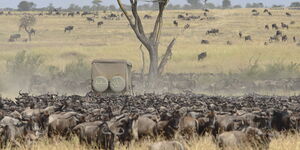Kenya is poised to cease the importation of shoes by 2027, a bold move by the government aimed at revitalising the domestic leather industry and creating thousands of jobs.
The announcement was made by President William Ruto on Saturday, June 1, during the nation’s 61st Madaraka Day celebrations in Bungoma County.
This decision to ban shoe imports follows an earlier declaration to halt the importation of maize by 2026. The impact of the shoe import ban is expected to be profound, affecting both the prices of this crucial commodity and the revenue margins of communities reliant on livestock.
President Ruto outlined the government’s strategic plans to eliminate the annual importation of 15 million pairs of shoes. "Our commercialisation agenda prioritises leather, dairy, and red meat value chains, supported by projects like the Livestock Commercialisation Project, which aids 11,000 vulnerable youth and women-led households in 10 counties," said Ruto.
The government aims to ramp up local shoe production from the current 8 million pairs per year to 36 million pairs, generating an annual turnover of Ksh72 billion. This ambitious target is set to boost income from Ksh15 billion to Ksh120 billion annually for Kenyans dependent on livestock for a living and create more than 100,000 jobs, up from the current 17,000.
To meet the demand met by shoe imports, President Ruto's government has announced a significant financial commitment of Ksh400 million to upgrade the Ewaso Ng’iro South Development Authority’s leather factory.
Out of this allocation, Ksh200 million will be used to acquire state-of-the-art equipment, Ksh100 million will be dedicated to constructing a new footwear factory, and the remaining Ksh100 million will be utilised for purchasing hides and skins.
"Machinery for increasing processing capacity at the factory has already been procured and installed. To supply quality hides and skins, 703 flayers have been trained, and subsidised flaying equipment provided to 680 slaughter points," President Ruto stated.
The President further emphasised the government's commitment to bolstering the leather sub-sector, highlighting its potential to support competitive export industries and numerous thriving enterprises and households.
"We are invested in developing our leather sub-sector to support competitive export industries supporting many thriving enterprises and households. In this connection, we have committed to implement strategies aimed at increasing incomes from Ksh15 billion to Ksh120 billion a year, multiplying job opportunities from 17,000 to 100,000 and raising annual footwear production from the current 8 million to 36 million pairs worth Ksh72 billion by 2027," he asserted.
The leather industry in Kenya has been undergoing transformation with a strategy launched eight years ago. This strategy included forming a council to drive the development of local industries and establishing a special economic zone for export-bound leather products.
In 2018, data for the second quarter showed imports stood at 5.2 million pairs of shoes valued at Ksh1.1 billion, marking a 7.4 percent decline from the first quarter, where Kenyans spent Ksh1.3 billion on 5.8 million pairs. Despite the decline, imports saw a rise in the third quarter with 6 million pairs of shoes brought in, reflecting a 17 percent increase.
Raw leather exports, however, have seen a significant drop. Over the past three years, exports have fallen by 43.7 perc ent in the last three quarters, with the lowest reported figure at 4,219 tonnes, earning tanneries Ksh779.3 million.
The increase in shoe imports in 2018, particularly during the third quarter, was driven by traders preparing for the December festivities and the back-to-school period. The Kenya National Bureau of Statistics’ 2018 Quarterly Balance of Payments report indicated that traders spent Sh1.4 billion on foreign-made shoes during this period.
This rise in imports contradicts the efforts of leather industry stakeholders to bolster local cobblers, small and medium enterprises, and major shoe factories to reach the 40 million pairs required annually to meet local demand.
Currently, Kenya imports most of its shoes from China, India, and Turkey. The new import ban is expected to significantly shift this dynamic, fostering the growth of the local leather industry and reducing dependency on foreign markets.












